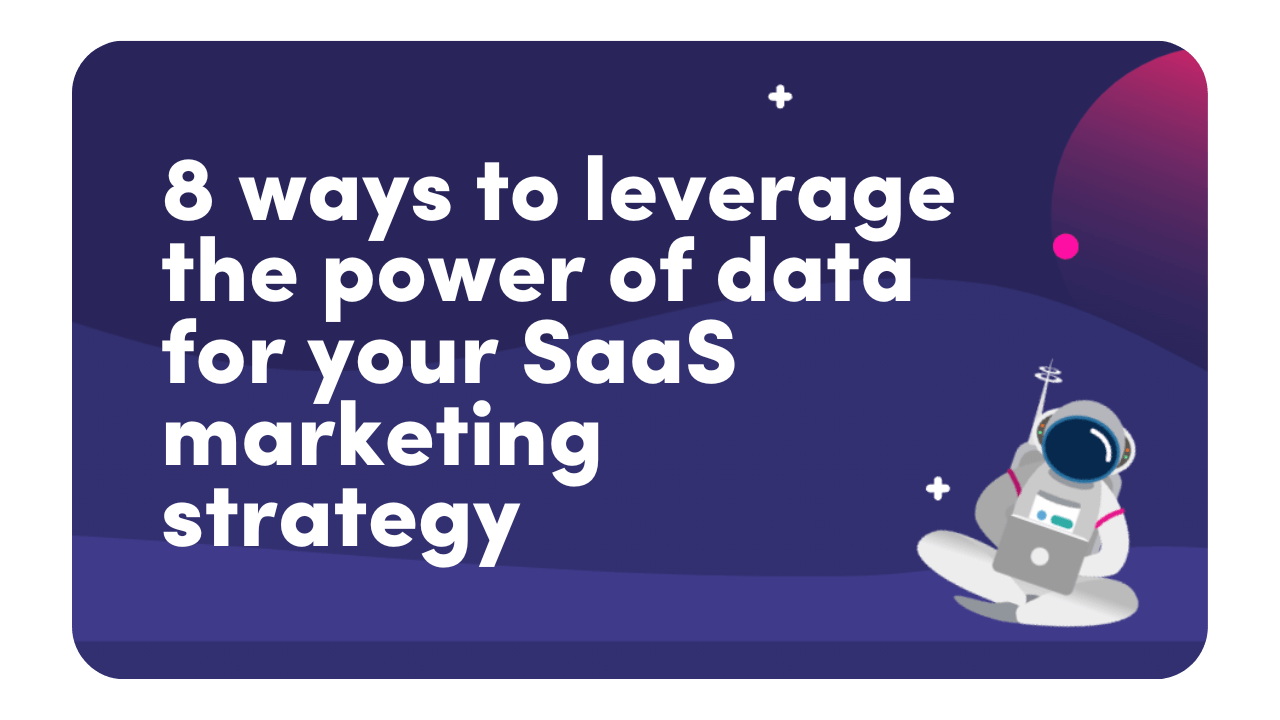Free SaaS marketing strategies & campaign ideas in your inbox every Thursday
Receive actionable SaaS marketing ideas to implement in your business
Insights, Marketing

As a SaaS marketer, you know that your business’s success hinges on your ability to generate quality leads, convert those leads into paying customers, and retain those customers over time.
But how can you ensure that your marketing efforts are driving the results you need to achieve your business goals? The answer lies in the goldmine that is SaaS data analytics.
Marketing analytics refers to the process of collecting, measuring, and analysing data related to your SaaS marketing activities.
By tracking metrics like website traffic, conversion rates, and user behaviour, you can gain valuable insights into how your marketing strategy is performing and identify areas for improvement.
The thing is, 95% of businesses encounter problems managing data. So, how can you unlock the power of data analytics? In this blog, we’ll explore 8 super smart and strategic ways you can use data analytics to drive SaaS marketing success.
Let’s get into it!
With SaaS marketing analytics, you can find clues to solve the mystery of why customers are not converting. Maybe your CTA needs a facelift, or perhaps your pricing isn’t quite right. It’s like a game of Clue but with numbers; look at the data to piece together the puzzle.
SaaS businesses can track which pages users visit most frequently, how long they stay on each page, and which calls-to-action (CTAs) they click on.
By analysing these marketing metrics, you can uncover which pages and CTAs are driving conversions and adjust your marketing strategies accordingly.
For example, if you notice that a particular CTA is generating a high number of clicks but few conversions, you may need to tweak the messaging or design to make it more compelling.
Your website is often the first point of contact between your business and potential customers. By using a marketing analytics platform like Google Analytics, you can track key metrics related to your website traffic, such as page views, bounce rates, and time on site.
By monitoring these metrics over time, SaaS companies are able to gain invaluable insights into how users are interacting with their website to see what needs optimising.
For example, if you notice a high bounce rate on a particular page, you may need to give it a little makeover with better content and imagery to make it more engaging for users.
Think of your marketing campaigns as a recipe. Use analytics to measure and adjust your ingredients (target audience, messaging, channels, etc.) until you get the perfect flavour and achieve the desired results!
By tracking metrics like click-through rates (CTRs), conversion rates, and cost-per-click (CPC), SaaS companies can identify which ad campaigns are performing best and allocate budget accordingly.
For example, if you notice that one ad campaign is generating a high CTR but a low conversion rate, you may need to adjust the landing page or offer to better align with user intent.
On the other hand, if you notice that another ad campaign is generating a high conversion rate but a high CPC, you may need to adjust the targeting or bidding strategy to improve cost efficiency. Don’t be afraid to experiment based on what the data is telling you.
One of the most important metrics for any SaaS business is monthly recurring revenue (MRR). But in order to grow your MRR, you need to generate new customers while keeping customer acquisition costs (CAC) as low as possible. This is where marketing analytics comes in.
By tracking key metrics like ad spend, average revenue, sales qualified leads (SQLs), and customer lifetime value (CLTV), you can calculate your marketing ROI and see what you can do to improve your customer acquisition cost.
For example, if you notice that your ad campaigns are generating many clicks but few SQLs, you may need to refresh your targeting or messaging to better align with your ideal customer profile.
Data analytics can also help your SaaS marketing team identify and target high-value customers. By analysing customer behaviour and demographics, you can create targeted marketing campaigns more likely to resonate with your most valuable customers.
For example, you might notice that your SaaS company’s highest-paying customers tend to be located in a particular region or industry.
By creating targeted ad campaigns that speak specifically to those customers, you can increase your chances of generating quality leads and driving revenue growth.
You can also use your SaaS marketing analytics to improve the efficiency of your sales teams. By tracking the effectiveness of various sales tactics and strategies, you can pinpoint areas for improvement and implement changes that lead to more sales and revenue growth.
For example, you might track the performance of your sales team by analysing data on lead generation, qualification, and conversion rates. By identifying bottlenecks and inefficiencies in the sales process, you can figure out how to streamline and optimise your sales strategy.
By tracking metrics like churn rate and customer engagement, you can determine which customers are at risk of churning and take proactive steps to retain them.
For example, if you notice that a particular customer has not logged in to your SaaS platform in several weeks, you may need to reach out to them with targeted messaging or offers to encourage them to re-engage.
Similarly, if you notice that a particular cohort of customers has a higher churn rate than others, you could send them surveys to figure out why they’re leaving and adjust your product or pricing based on their feedback.
Like what you’re learning? We think you’ll also enjoy this blog, “How to leverage customer feedback for your SaaS marketing strategy.” Give it a read!
CLV is a crucial metric for SaaS businesses, as it helps you understand the long-term value of your customers. By using marketing analytics to analyse customer behaviour, you can identify patterns and trends to help you optimise CLV.
For example, you might see that customers who use a particular feature tend to stick around longer and spend more money. Promoting that feature more heavily and improving its functionality can encourage more customers to adopt it and increase your CLV.
60% of companies around the world use data and analytics to drive process and cost-efficiency, we hope now you can see why! Data analytics is a powerful tool for SaaS marketers and companies looking to drive better SaaS marketing and sales performance.
By leveraging marketing analytics tools and platforms, SaaS marketers can gain valuable insights into user behaviour, marketing metrics, and essential data trends to measure how well your campaigns are performing and improve them.
Don’t have time to mess around with heaps of SaaS marketing data and Google Analytics to build more strategic and effective marketing campaigns? We’ve got you covered.
With rolling monthly price plans starting from just £3,000 per month, we join or become your dedicated SaaS marketing and web design partner, taking your online presence to sky-high success with proven content strategies, comprehensive digital marketing, and high-converting websites.
Get in touch with us today to get the ball rolling or apply for your free marketing strategy call.
Receive actionable SaaS marketing ideas to implement in your business
Email: info@rocket-saas.io






By Ryan James

